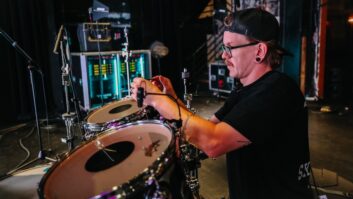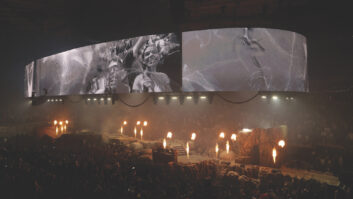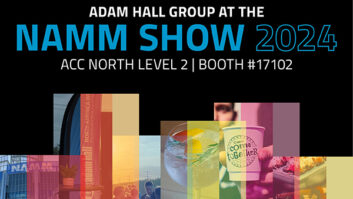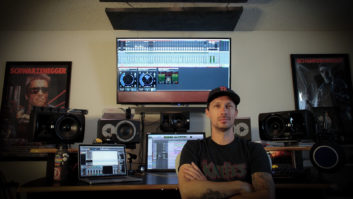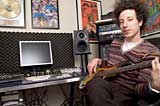
Los Angeles–based bassist and songwriter Justin Meldal-Johnsen has worked and toured with top artists—Beck, Garbage (Bleed Like Me), Ima Robot (Ima Robot), Macy Gray (Trouble With Being Myself), Air (10,000Hz Legend)—composed original songs, contributed to movie scores (In Good Company, The Dukes of Hazzard, The Devil’s Rejects) and more during his years as a musician. Twelve years ago, he and producer Tony Hoffer (Beck, Air, Supergrass, Fischerspooner) built a project studio to support Meldal-Johnsen’s songwriting and to develop basic recording skills—a workplace that continues to evolve along with his projects.
Featuring some of Meldal-Johnsen’s favorite basses—old, new and upright—made by Fender, Guild, Gibson, Vox and more, he notes that the studio, a room in his home, “started out with an ADAT and a tiny Mackie board on a rickety table. The studio is used for writing songs and programming, but more often it is becoming a space useful for bass overdubs.” The space, which includes a “little hallway with high ceilings and a nice-sounding oak hardwood floor outside of the room, [is] used for room effect on a small drum set, percussion, vocals and acoustic guitar. Otherwise, I do most of my miked recording right between the speakers with headphones for the more standard dry, tight sound,” says Meldal-Johnsen. Shure SM7, a KSM-44, a Rode NT1 and a pair of SM81s are used for recording.
More and more frequently, Meldal-Johnsen’s process of contributing to sessions remotely entails Pro Tools HD|2—recording tracks and then sending them to his collaborators and clients via Digidesign’s DigiDelivery or FedEx, so that he can “spend time getting an ideal bass sound, try a bunch of ideas and comp the takes so there are a few alternative versions.”
Meldal-Johnsen plugs his bass into a Radio/Swtchbone A/B/Y box, then the signal goes to a tuner, a DI and an amp. The amp signal passes through a pair of custom switch boxes, each on a separate 36×20 pedalboard. The true bypass switches provide a total of 26 dedicated effects loops, each with a pedal attached. He notes that, “This is ideal for having a lot of pedals at my disposal, yet not actually having them ‘in line’ until I need them. It’s like a poor man’s version of those nice custom rack-based switching systems.” From the switchers, the signal connects to an Ampeg B-15 or SVT and, at times, a third source—a guitar amp.
At every step of his performance he uses plug-ins—a range of Digidesign (Bomb Factory, Waves, Amp Farm, Echo Farm), Native Instruments (Battery, Pro53, B4, Absynth and FM7) and Reason products. When writing, they are used to, “cast a particular character over what I’m doing,” says Meldal-Johnsen, “But I’m also a believe in using outboard gear liberally as well. There are certain analog delays and spring reverbs in my outboard collection that I patch into my Digi interface and use as sends.”
Meldal-Johnsen emphasizes the importance of keeping the same spontaneity in session work as he does on stage, saying, “When I record bass, I don’t sit there and play four bars at a time and then tweak it to eternity. I go for entire performances, because I know they will feel better, and plus it’s just more fun to pretend like it’s live and I’m performing for the people in the room. I just punch in sparingly into a whole take if I need to, because I don’t want to avoid my responsibility as a player; I assume, just like any other musician in my position, that people are hiring me because of my feel and approach, not to receive a digitally-enhanced, kinder, gentler facsimile. If I’m going to tap-dance on some pedals or do drastic shifts between song sections, I’d better be able to do that on stage!”
